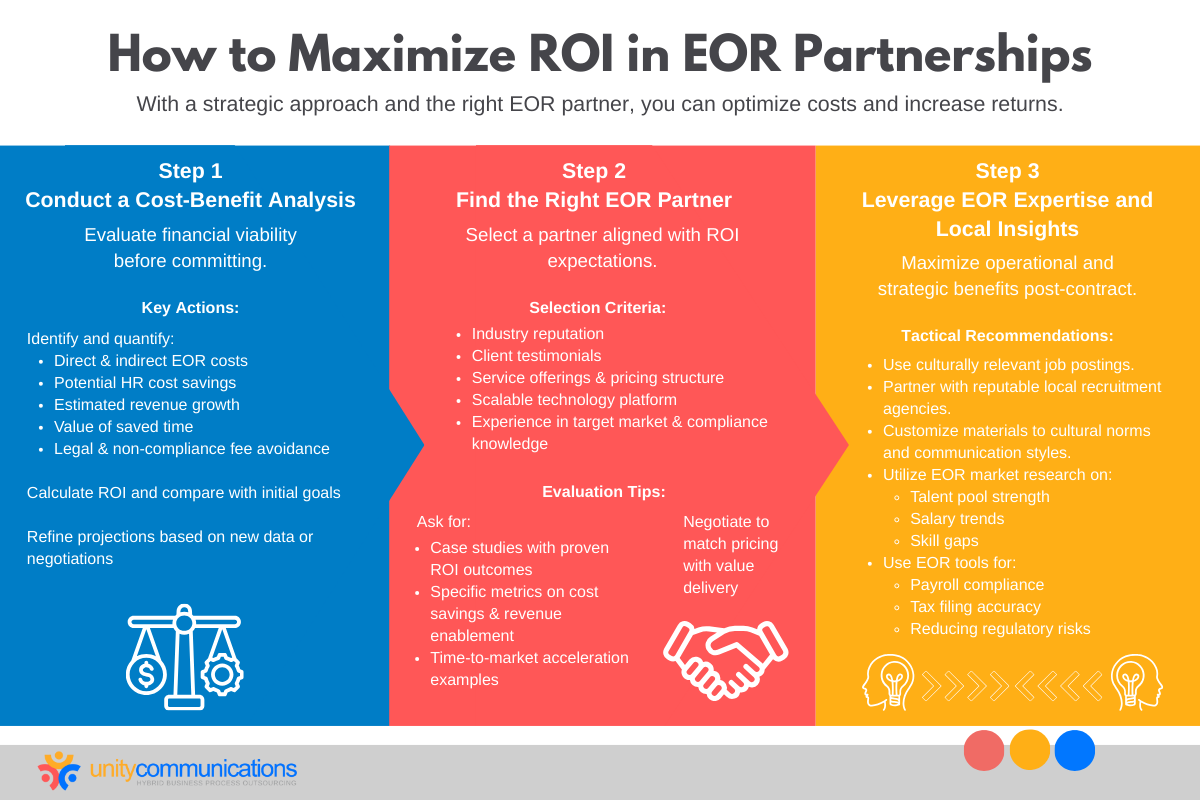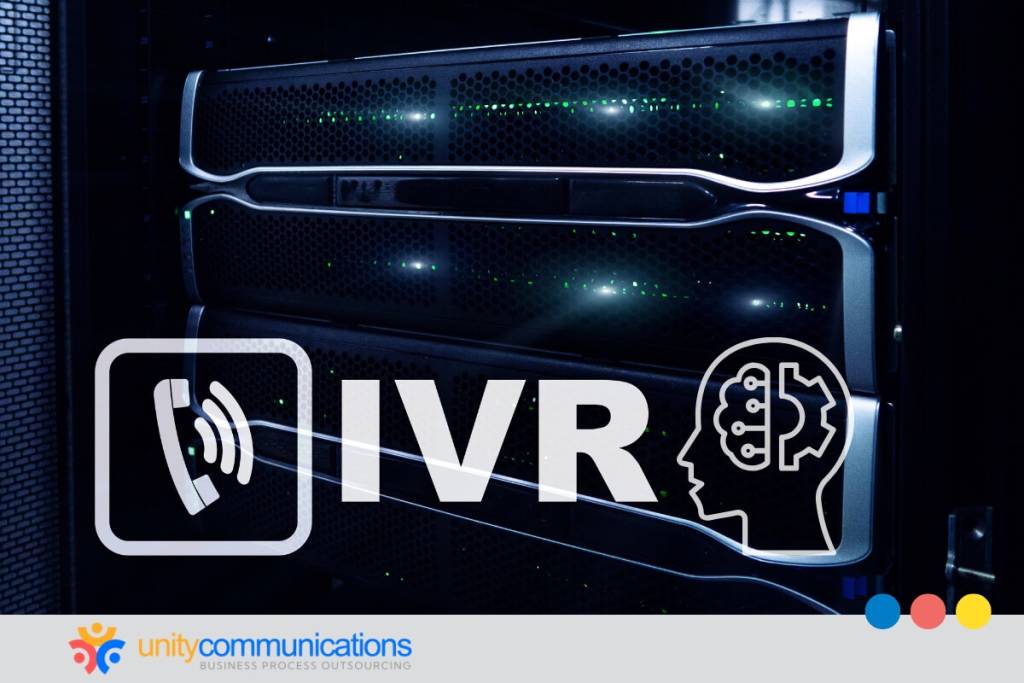Table of Contents
As a strategy for global workforce acquisition and new market entry, employer of record (EOR) services promise cost efficiency for growing businesses needing human resource (HR) support. However, employer of record partnerships don’t always guarantee a positive return on investment (ROI).
Keep reading to learn how to maximize ROI when leveraging EOR services for global expansion. This article explores the key components that contribute to these returns, strategies for optimizing them, and metrics for measuring their success.
A brief introduction to EOR services

Similar to information technology (IT) support outsourcing, EOR services are a form of business process outsourcing (BPO). However, EOR services offer a more nuanced approach than outsourcing and involve delegating HR processes to an external provider.
Service vendors act as the legal employer on behalf of the client company. They handle various tasks associated with workforce management, such as:
- Payroll management
- Benefits administration
- Regulatory compliance
- Tax withholding
- Onboarding and offboarding
The nature of their work allows them to simplify global talent acquisition and expansion, which is why EOR services became popular during the 2020 pandemic. Everest Group stated the EOR market grew by 170% in 2020. The rise of gig work also helped cement the industry, allowing it to potentially reach $6.6 billion by 2030.
How employer of record services contribute to ROI
The advantages of EOR services go beyond simply having a third party manage payroll and taxes. A strategic partnership can significantly contribute to cost savings in several areas, including legal compliance, HR operations, and market entry costs.
Let’s discuss the critical contributors to ROI in EOR partnerships:
1. Simplified legal compliance and mitigated risks
Navigating international employment laws and tax regulations can be time-consuming and resource-intensive. An EOR covers compliance processes, freeing your staff from the complexities of ensuring adherence.
An EOR offers data entry services, leveraging dedicated expertise and automation tools to minimize errors in recordkeeping and tax filing. Some of the more complex processes it covers include:
- Obtaining work visas and permits
- Managing employment contracts
- Staying up-to-date with changes
With specialists handling compliance, you can reduce the risk of fines and penalties associated with violations. Ensured compliance can potentially save significant costs. Additionally, avoiding legal issues associated with noncompliance, such as lawsuits, government investigations, and business license suspension, protects the business’s finances and operational stability.
2. Streamlined HR operations and optimized resources
An employer of record helps you achieve a positive ROI by reducing your business’s administrative burden.
Managing payroll, benefits administration, and other HR tasks, whether for a global or local workforce, is tedious, especially for smaller companies. Offloading these processes reduces overhead expenses in equipment and labor.
Additionally, EOR providers leverage economies of scale, allowing them to offer services at a more competitive rate than managing HR tasks in-house.
You can reallocate the resources and time you saved through the EOR partnership toward activities that boost your profitability, such as:
- Developing and implementing effective talent acquisition strategies
- Creating and delivering engaging employee training and development programs
- Designing and implementing performance management systems
- Focusing on employee engagement initiatives
These strategic efforts significantly increase employee morale and engagement, enhancing operational efficiency and productivity.
3. Accelerated market entry and reduced costs
Setting up a foreign subsidiary is a lengthy and expensive process that involves the following costs:
- Legal fees
- Registration expenses
- Tax registration
- Office space rent
- Infrastructure investments
- Minimum capital requirements
These costs can eat into your initial budget for market entry and potentially delay your returns. Partnering with an EOR can save you significant time and money.
An EOR already has established agencies in the locations where they operate. This feature lets you start immediately working with local talent, capturing opportunities, and generating revenue.
Leveraging employer of record services also frees up capital, which can be optimized for other areas of business growth, allowing you to achieve high ROI faster.
How to maximize ROI in EOR partnerships

EOR services can help you save and optimize expenses but cannot guarantee a positive return. The key to achieving high ROI is a strategic partnership that maximizes the benefits and features offered by the service provider.
With adequate preparation and proactive collaboration, you can save on costs and see positive results in your EOR investments. Build a profitable strategic partnership with the following steps:
1. Conduct a cost-benefit analysis
Quantify the costs and benefits associated with leveraging EOR services. Compare the projected expenses, savings, and potential revenue gains to make more informed decisions.
Factors to consider when conducting a cost-benefit analysis include:
- Direct and indirect EOR costs
- Potential HR cost savings
- Potential revenue growth
- Estimated value of saved time
- Legal fees and potential non-compliance fees
Once you have identified these costs and benefits, calculate your ROI and analyze the results against your initial objectives. Is partnering with an EOR justifiable or cost-effective? Refine your analysis if further research or negotiation changes your estimates.
2. Find the right EOR partner
As your company’s legal employer on record, the service provider plays a significant role in helping you gain a positive ROI. When choosing an EOR partner, check your prospects’ history in your target markets, industry experience, and familiarity with local regulations.
Some factors to consider when scouting providers include the following:
- Industry reputation
- Client testimonials
- Service offerings
- Cost structure
- Technology scalability
When screening your short-listed EOR companies, evaluate them with an ROI lens. Request case studies or references demonstrating their success in helping clients achieve similar returns. Ask them questions that directly relate to maximizing ROI, such as:
- How can your services help us achieve a faster time to market in our target regions?
- What specific features and services will you offer to reduce our overhead HR costs?
- Can you quantify the potential revenue gains we can achieve with your services?
However, although costs are significant, prioritizing an EOR that offers the best value proposition for your ROI goals is also critical. Remember to negotiate with your prospects to align their pricing with the value they deliver.
3. Leverage EOR expertise and local insights
Once you have signed a contract with an EOR provider and integrated its services into your existing systems, collaborate to streamline operations and decision-making. Below are some tips to consider:
- Develop culturally tailored job postings. Leverage your EOR’s local expertise to ensure your posting’s terminology, tone, references, and visuals resonate with your target audience.
- Leverage your EOR’s network with local recruitment agencies. Discuss your hiring needs and target market with your partner. Ask for recommendations for recruitment agencies with a strong track record in your desired industry and location to access a pre-vetted pool of candidates.
- Tailor onboarding programs to local cultural norms. Develop onboarding materials that explain company policies, benefits, and expectations in a way that respects local customs and communication styles.
- Conduct targeted market research. Utilize reports from your EOR on local talent pools, skill gaps, and salary trends to refine your strategy for attracting and retaining top local talent.
- Utilize EOR technology for regulatory compliance. EORs typically have tools that help streamline compliance. Leverage these technologies to ensure accuracy and efficiency in payroll processing, tax filings, and other regulated tasks.
Working with an employer of record on these strategies maximizes your ROI. It allows you to develop competitive compensation packages and adapt hiring strategies to attract and onboard the right talent faster. By speeding up the process and minimizing hiring errors, you can reduce recruitment and onboarding costs.
Additionally, adapting culturally sensitive practices fosters a more engaged workforce and improves employee retention. This leads to increased productivity and reduces costs associated with laying off and hiring employees, translating to a positive ROI.
A quick guide to measuring the success of ROI in EOR partnerships
Regularly monitoring your chosen employer of record’s processes and progress ensures that the partnership contributes to a positive ROI. How do you do it?
First, leverage key performance indicators (KPIs) and metrics to gain objective data to evaluate your provider’s performance. These include:
- Cost and efficiency KPIs (e.g., cost per hire, time to hire, payroll processing time, and administrative cost savings)
- Talent acquisition KPIs (e.g., quality of hire, candidate pool growth, time to fill critical positions, and employee retention rate)
- Compliance KPIs (e.g., number of compliance errors and time spent on compliance tasks)
- Overall business KPIs (e.g., revenue growth, market expansion success, and improved employer branding)
Second, assess the effectiveness and ROI of your partnership by comparing the data measured by those factors before and after integrating EOR services.
Additionally, calculate the percentage reduction in times spent and compliance incidents achieved by leveraging EOR services. Monitoring the accuracy and completeness of employee data collected and managed by your provider also gives you insight into its services’ effectiveness.
The bottom line

EOR partnerships are valuable investments for market expansions and global talent acquisition.
However, finding an EOR partner that aligns with your goals, needs, and budget can better help you achieve a positive ROI. Leveraging its expertise and resources simplifies international regulatory compliance, streamlines HR processes, and accelerates time to market.
These benefits translate to improved cost optimization and focus on core competencies, generating successful returns.
Let’s connect if you want to learn more about how employer of record services affect your ROI.




